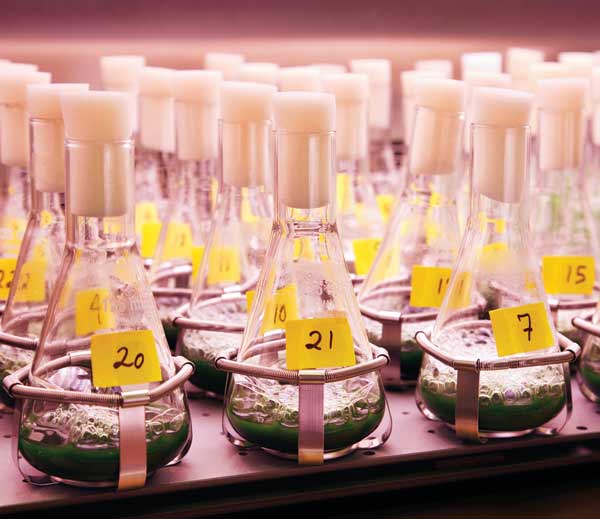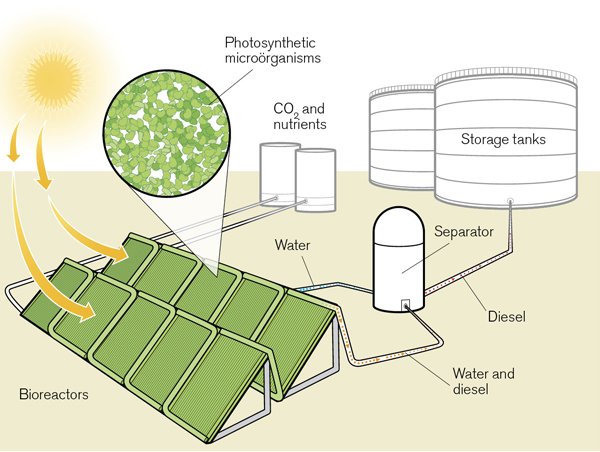Solar Fuel

When Noubar Afeyan, the CEO of Flagship Ventures in Cambridge, MA, set out to invent the ideal renewable fuel, he decided to eliminate the middleman. Biofuels ultimately come from carbon dioxide and water, so why persist in making them from biomass–corn or switchgrass or algae? “What we wanted to know,” Afeyan says, “is could we engineer a system that could convert carbon dioxide directly into any fuel that we wanted?”
The answer seems to be yes, according to Joule Biotechnologies, the company that Afeyan founded (also in Cambridge) to design this new fuel. By manipulating and designing genes, Joule has created photosynthetic microörganisms that use sunlight to efficiently convert carbon dioxide into ethanol or diesel–the first time this has ever been done, the company says. Joule grows the microbes in photobioreactors that need no fresh water and occupy only a fraction of the land needed for biomass-based approaches. The creatures secrete fuel continuously, so it’s easy to collect. Lab tests and small trials lead Afeyan to estimate that the process will yield 100 times as much fuel per hectare as fermenting corn to produce ethanol, and 10 times as much as making it from sources such as agricultural waste. He says costs could be competitive with those of fossil fuels.
If Afeyan is right, biofuels could become an alternative to petroleum on a much broader scale than has ever seemed possible. The supply of conventional biofuels, such as those made from corn, is constrained by the vast amount of water and agricultural land needed to grow the plants they’re made from. And while advanced biofuels require less water and don’t need high-quality land, their potential is limited by the expensive, multistep processes needed to make them. As a result, the International Energy Agency estimates that in 2050, biodiesel and ethanol will meet only 26 percent of world demand for transportation fuel.
Joule’s bioengineers have equipped their microörganisms with a genetic switch that limits growth. The scientists allow them to multiply for only a couple of days before flipping that switch to divert the organisms’ energy from growth into fuel production. While other companies try to grow as much biomass as possible, Afeyan says, “I want to make as little biomass as I can.” In retrospect, the approach might seem obvious. Indeed, the startup Synthetic Genomics and an academic group at the BioTechnology Institute at the University of Minnesota are also working on making fuels directly from carbon dioxide. Joule hopes to succeed by developing both its organisms and its photobioreactor from scratch, so that they work perfectly together.

Still, it’s a risky strategy, since it departs from established processes. Usually, a startup sets out determined to do something novel, says James Collins, a professor of biomedical engineering at Boston University and a member of Joule’s scientific advisory board, “and it falls quickly back on trying to find something that works … an old thing that’s been well established.” Afeyan, however, has pushed the company to stay innovative. This summer, it will move beyond lab-scale tinkering; an outdoor pilot plant is currently under construction in Leander, TX.
As both a venture capitalist and a technologist–he received his PhD in chemical engineering from MIT in 1987–Afeyan is keenly aware of the challenges in demonstrating that a novel process can operate economically and make fuel in large volumes. To minimize the financial risks, he steered Joule toward a modular process that doesn’t require large and expensive demonstration plants.
“I’m not saying it’s easy or around the corner, because I’ve done this for a long time,” Afeyan says. But he does believe that Joule is onto something big: a renewable fuel that could compete with fossil fuels on both cost and scale. He says, “We have the elements of a potentially transformative technology.”
Keep Reading
Most Popular
Large language models can do jaw-dropping things. But nobody knows exactly why.
And that's a problem. Figuring it out is one of the biggest scientific puzzles of our time and a crucial step towards controlling more powerful future models.
How scientists traced a mysterious covid case back to six toilets
When wastewater surveillance turns into a hunt for a single infected individual, the ethics get tricky.
The problem with plug-in hybrids? Their drivers.
Plug-in hybrids are often sold as a transition to EVs, but new data from Europe shows we’re still underestimating the emissions they produce.
Google DeepMind’s new generative model makes Super Mario–like games from scratch
Genie learns how to control games by watching hours and hours of video. It could help train next-gen robots too.
Stay connected
Get the latest updates from
MIT Technology Review
Discover special offers, top stories, upcoming events, and more.